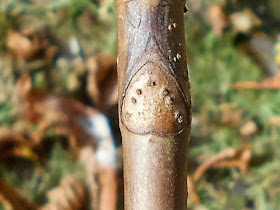The shedding of leaves is of course, amongst other things, an excretory mechanism. A number of abscissional cells develop to form a weak point at the petiole base, allowing the leaf to fall without damaging the tree. As the leaf falls it leaves a scar and in the case of the Horse Chestnut it is very distinctive. The scar resembles a horseshoe, complete with nails, and it is widely believed that this feature has given the tree its common name. For clarity (?) I have shown the scar upside down.
 |
Horse Chestnut twig. Stefen Leys Pocket Park, Daventry.
10 October, 2016
|
As the leaves fall they take with them various substances such as tannins which would otherwise be harmful. These unwanted substances can include toxic metals and much interest is being shown in using trees not only to remove these metals from contaminated soils, but as a way of 'harvesting' these potentially valuable materials.
 |
Oak leaves turning gold. Aston le Walls Pocket Park.
9 October, 2016
|
So the leaf, in falling, takes with it unwanted and harmful chemicals. But there is another very good, obvious, yet often overlooked reason why a tree will shed its leaves. As summer advances the leaves will begin to experience many kinds of attack from other organisms to a point where a leaf is rendered almost useless.
One source of trouble can be galls. The photograph shows a dozen or so galls of Neuroterus quercusbaccarum, the Common Spangle Gall. These are overwhelmingly on the under side of an oak leaf and a group like this will probably not have much effect.
 |
Oak leaf with Spangle Galls. Aston le Walls Pocket Park.
9 October, 2016
|
However, the upper side of the leaf is also affected, and a severe attack will render the leaf unable to photosynthesise.
 |
The upper side of the galled leaf.
|
Some problems can be referred to mildews. The leaves of this sycamore, Acer pseudoplatanus, photographed recently in Byfield, have been attacked by Uncinula aceris, making the leaf look as though it has been splashed with white paint. Again, they will now perform very inefficiently.
 |
| Acer sapling beside Byfield Village Hall. 12 October, 2016 |
Also affecting sycamore is the fungus known as Tar Spot, Rhytisma acerinum. It has been known from Europe since 1794 and, according to the literature, can affect a number of Acer species. However I have only found it on sycamore; Field Maple, Acer campestre, seems largely unaffected even when the two species are growing side by side. Cleaner air was thought to be allowing the disease to become more prevalent but there is little evidence to back this up.
 |
| Tar Spot on sycamore, Badby Road West, Daventry. 14 October, 2016 |
Caterpillar damage is also an obvious problem. In my own garden my Rose 'Canary Bird' has had some of the leaves skeletonised by the larvae of the Rose Slug Sawfly, Endelomyia aethiops.
 |
Damage caused by the Rose Slug Sawfly, Stefen Hill,
Daventry. 19 October, 2016
|
These now-useless leaves can be shed during the autumn but the caterpillars will have formed a cocoon in the soil beneath the rose; they will return next spring to wreak further havoc unless I take appropriate measures. Incidentally males of this species are extremely rare and so reproduction is almost invariably by parthenogenesis. As a rule the depredations of caterpillars are of little consequence but severe infestations by, for example, box tree caterpillars, can eventually lead to the death of the affected plant.
There is no doubt that the autumn leaf fall is a phenomenon worthy of our attention and not just Nature's way of providing us with beautiful photographs.
There is no doubt that the autumn leaf fall is a phenomenon worthy of our attention and not just Nature's way of providing us with beautiful photographs.
No comments:
Post a Comment